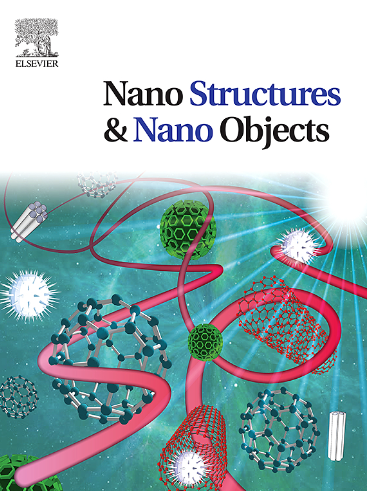从菝葜根提取物中合成的生物纳米银:一种具有抗菌特性的绿色方法
IF 5.45
Q1 Physics and Astronomy
引用次数: 0
摘要
银纳米粒子(AgNPs)由于其独特的物理化学性质,如高导电性和导热性、增强的表面拉曼散射、化学稳定性、催化活性,以及最显著的强抗菌、抗真菌和抗病毒作用,已经获得了重要的研究兴趣和实际应用。在AgNP的合成方法中,植物提取物的绿色合成因其稳定性、可持续性、强生物活性、安全性和环境友好性而备受关注。本文报道了利用菝葜根提取物合成AgNPs的新数据。利用扫描电子显微镜、x射线衍射、能量衍射光谱和红外光谱对制备的AgNPs进行了表征。采用琼脂扩散法和分光光度法对A700细菌病原菌(包括敏感和耐药金黄色葡萄球菌、大肠杆菌和变形链球菌)的抑菌活性进行了检测。用家兔评价AgNPs的局部毒性。结果表明,AgNPs分布均匀,呈球形,粒径在20 ~ 50 nm之间。该纳米颗粒对所有被测微生物均具有抗菌活性,包括金黄色葡萄球菌ATCC 25923(抗生素敏感菌株)、耐药金黄色葡萄球菌ATCC 29213、ATCC 12493、252、大肠杆菌25922和龋齿变形链球菌GS-5。值得注意的是,AgNPs在试验家兔中未检测到局部毒性。因此,获得的数据支持这些AgNPs在实践中的应用,例如在口腔保健或皮肤产品中。本文章由计算机程序翻译,如有差异,请以英文原文为准。
Biogenic silver nanoparticles synthesized from Smilax glabra root extract: A green approach with antimicrobial properties
Silver nanoparticles (AgNPs) have garnered significant research interest and practical applications due to their unique physicochemical properties such as high electrical and thermal conductivity, enhanced surface Raman scattering, chemical stability, catalytic activity and, most notably, strong antibacterial, antifungal, and antiviral effects. Among the methods for AgNP synthesis, green synthesis using plant extracts is of particular interest because of its stability, sustainability, strongbiological activity, safety and environmental friendliness. This work presented the novel data on synthesis of the AgNPs using the Smilax glabra Roxb root extract. The fabricated AgNPs were characterized using scanning electron microscopy, X-ray diffraction, energy diffractive spectroscopy, and fourier-transform infrared spectroscopy. The anti-bacterial activity against bacterial pathogens, including antibiotic susceptible and resistant Staphylococcus aureus, Escherichia coli and Streptococcus mutans, was examined using agar diffusion and spectrophotometric methods at A700. The local toxicity of AgNPs was evaluatedin rabbits. The results showed that AgNPs had uniform distribution and spherical shape with the particle size in ranging from 20 to 50 nm. The nanoparticles exhibited antibacterialactivity against all tested microorganisms, including S. aureus ATCC 25923 (antibiotic- susceptible strain), antibiotic-resistant S. aureus strains ATCC 29213, ATCC 12493, 252, E. coli 25922 and dental caries bacterium S. mutans GS-5. Remarkably, no local toxicity of AgNPs was detected in the tested rabbits. Thus, the obtained data support the applications of these AgNPs in practice, such as in oral health care or dermal products.
求助全文
通过发布文献求助,成功后即可免费获取论文全文。
去求助
来源期刊

Nano-Structures & Nano-Objects
Physics and Astronomy-Condensed Matter Physics
CiteScore
9.20
自引率
0.00%
发文量
60
审稿时长
22 days
期刊介绍:
Nano-Structures & Nano-Objects is a new journal devoted to all aspects of the synthesis and the properties of this new flourishing domain. The journal is devoted to novel architectures at the nano-level with an emphasis on new synthesis and characterization methods. The journal is focused on the objects rather than on their applications. However, the research for new applications of original nano-structures & nano-objects in various fields such as nano-electronics, energy conversion, catalysis, drug delivery and nano-medicine is also welcome. The scope of Nano-Structures & Nano-Objects involves: -Metal and alloy nanoparticles with complex nanostructures such as shape control, core-shell and dumbells -Oxide nanoparticles and nanostructures, with complex oxide/metal, oxide/surface and oxide /organic interfaces -Inorganic semi-conducting nanoparticles (quantum dots) with an emphasis on new phases, structures, shapes and complexity -Nanostructures involving molecular inorganic species such as nanoparticles of coordination compounds, molecular magnets, spin transition nanoparticles etc. or organic nano-objects, in particular for molecular electronics -Nanostructured materials such as nano-MOFs and nano-zeolites -Hetero-junctions between molecules and nano-objects, between different nano-objects & nanostructures or between nano-objects & nanostructures and surfaces -Methods of characterization specific of the nano size or adapted for the nano size such as X-ray and neutron scattering, light scattering, NMR, Raman, Plasmonics, near field microscopies, various TEM and SEM techniques, magnetic studies, etc .
 求助内容:
求助内容: 应助结果提醒方式:
应助结果提醒方式:


